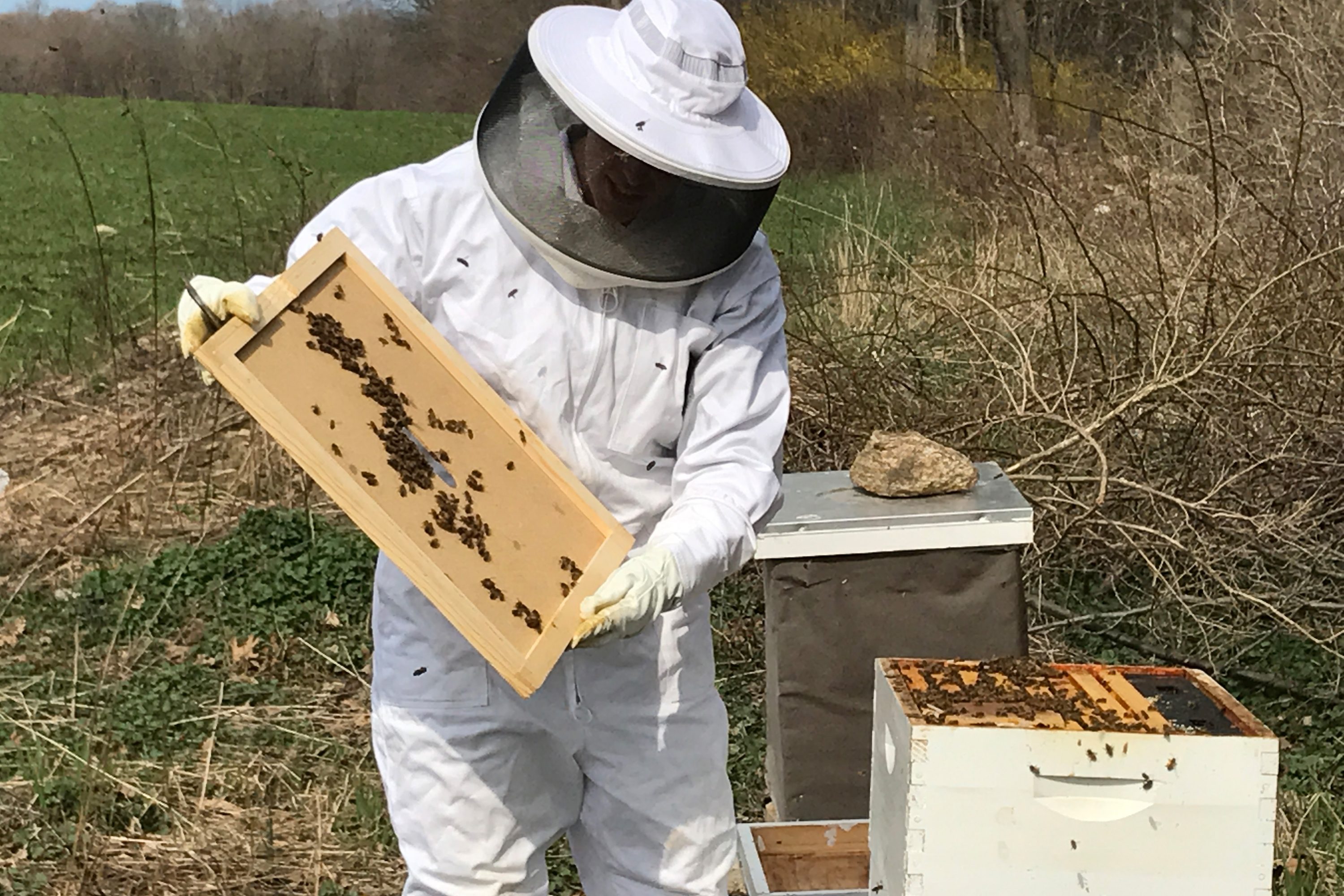It is barely five minutes away from campus by car, but the UConn EcoGarden is a hidden sanctuary for senior rower Arielle Sherman-Golembeski and other members of the University’s Beekeeping Club.
Drive up the dirt road, park in an empty field, and walk behind the vegetable gardens to find active beehives in the springtime. It’s a place of relaxation for a student-athlete, a time to take a break in her demanding schedule.
The Beekeeping Club is one of the less well-known student organizations at UConn and definitely one of the least understood, but for Sherman-Golembeski ’17 (CLAS), the bees represent more than just the stereotypical stingers that many people try to avoid.
“I really didn’t like bees when I was younger, like anyone else, but I didn’t understand the beauty of what they actually do until I educated myself more,” says Sherman-Golembeski, who is vice president of the club.
Sherman-Golembeski, a double major in psychology and human development and family studies, is a three-time member of the AAC All-Academic Team, and will be honored as an Outstanding Scholar-Athlete at the UConn Club Awards Ceremony on April 26.
While attending Lyme-Old Lyme High School, she was tasked with completing a senior project of her choosing. With her mom’s friend as a mentor, she shadowed the art of beekeeping and had her project topic.
With the stress of everything going on, I need a place to ground myself. It’s nice to be around organic things, as opposed to books and weights.” — Arielle Sherman-Golembeski
Since coming to UConn, a successful rowing and academic career has not stopped her from being an active member of the Beekeeping Club since 2013 – her freshman year and also the year the club was founded.
“We’re definitely up and coming,” she says. “When I heard UConn had this club, I knew it was something I wanted to do. We have maybe 10 kids, most without any prior knowledge of bees.”
The members of the club engage in hands-on and educational activities related to beekeeping.
Mid-April was the first time Sherman-Golembeski had visited the hives since before the winter. During the colder months, the bees eat their supply of honey, and the hive boxes go untouched to keep the necessary warmth bottled inside.
For such small creatures, the organizational structure of a hive is quite impressive.
“This is how the hive is composed – you have males or drones, females or worker bees, and then the queen bee,” says Sherman-Golembeski. “Only females go out and gather nectar, so they are the ones people see roaming around outside. The role of the males is to mate with a fertile queen.”
She adds, “The real worker bees are the females, which is kind of cool because of gender stereotypes. Bees defy that kind of thinking.”
Female bees bring pollen and nectar back to the hive, where they turn the nectar into honey. For some beekeepers, honey is produced in their hives at such a rapid rate that they are able to sell it. At UConn, the club leaves the honey for the bees’ winter consumption.
The queen bee is the most crucial, as she is the only one who reproduces and therefore provides sustainability for the entire hive. The other bees follow her lead without question.
“We ordered some packages of bees. They come in smaller boxes, and you have a separate cell with the queen in it,” says Sherman-Golembeski. “When the queen moves, some of the bees move with her. If the queen stays in her cell, the others will stay too.”
When the bees swarm, meaning they leave the hive and find another place to live, the queen leaves the hive with a fraction of the worker bees, leaving behind a larval queen (who will soon hatch) and the remaining workers. The swarm process produces two hives; the original at the original location and the new hive established by the swarm at a location chosen by scout worker bees.
The comb-design inside the hives allows the females, who travel up to two miles away from the hive for nectar, to deposit the nectar. The frame of the combs is usually made of plastic.
The club holds meetings every other week, but while the weather was cold, there wasn’t much opportunity to visit the hives. “I’ll come out here sometimes to check on them myself,” says Sherman-Golembeski. “You don’t want to open the box too frequently; you just want to let them do their thing.”
She notes that bee-keeping is easier than having a dog as a pet. “You don’t have to walk them or anything,” she says. “You just maintain them.”
For the Husky rower, it allows her a chance to get away from both class and practice to enjoy the beauty of nature.
“It provides a place to sit and relax with nothing around you except creatures who are doing good things for the environment,” she says. “With the stress of everything going on, I need a place to ground myself. It’s nice to be around organic things, as opposed to books and weights.”
With her four-year tenure at UConn coming to an end, Sherman-Golembeski is already looking forward to revisiting the hives after graduation to see how her friends are doing – both in the club and in the hives.
Watch Sherman-Golembeski discussing her hobby here.



